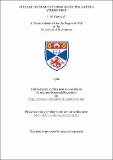Files in this item
Stellar photometry from above the earth's atmosphere
Item metadata
| dc.contributor.advisor | Stibbs, D. W. N. | |
| dc.contributor.author | Campbell, J. W. | |
| dc.coverage.spatial | 239 p. | en_US |
| dc.date.accessioned | 2018-06-20T10:36:40Z | |
| dc.date.available | 2018-06-20T10:36:40Z | |
| dc.date.issued | 1980 | |
| dc.identifier.uri | https://hdl.handle.net/10023/14323 | |
| dc.description.abstract | Although relative ground based stellar photometry has been an established investigative technique for many years, there have been very few programmes which have provided absolute stellar fluxes and indeed where such results have been published, they have been derived mainly from spectro-photometric data for a few bright stars. Such measurements are essential for the confirmation of model atmosphere calculations and for those models relating to early type stars, it is essential to extend such observations well into what is known as the vacuum ultraviolet region, i.e. below 3000A. The measurements are technically very difficult because of the need to use balloon or rocket platforms and when this work was started in 1962, only a very few observations had been conducted by the Naval Research Laboratory in Washington using very simple photometers with no absolute calibration. Under the auspices of a Senior Research Fellowship (the first in Scotland), held at the Royal Observatory, Edinburgh, the author proposed to the newly formed European Space Research Organisation, a number of stellar investigations aimed at obtaining absolute stellar fluxes in the region 1200Å - 2800Å. This thesis gives an account of almost a decade spent in developing the techniques of rocket astronomy and absolute calibration in the vacuum ultraviolet. Since no other European groups were engaged in similar studies, it was necessary for the author to essentially begin at the very beginning and a substantial period was spent in designing and testing optical systems which would withstand a typical Skylark Rocket launch. Systems of this type had never been flown before and many hours of vibration testing were necessary to ensure a satisfactory optical and mechanical configuration. The choice of a suitable ultraviolet detector was not easy and a substantial part of the early laboratory research was aimed at evaluating commercially available detectors and in the end an entirely new range of photo-multipliers was developed as a co-operative venture between the author and E.M.I. Hayes, Middlesex, resulting in a commercially saleable product. Wavelength isolation techniques were developed and the use of reflective mirror surfaces was successfully pioneered. A complete range of rocket-borne electronic systems was developed including solid state electrometers and high voltage power supplies. The techniques for encapsulating photomultipliers to withstand the rocket environment and the mounting of large optical mirrors were successfully developed and over fifty telescopes constructed and launched. The problems of calibrating on an absolute basis these rocket borne telescopes of large aperture were investigated and a network of traceable sub-standards was developed which ensured comparison with other (American) data. Highly stable microwave sources were developed and detectors calibrated at several national laboratories. These techniques were eventually used in the calibration of the T.D.I. S2/68 satellite experiment. The problem of integration of the payloads at centres throughout Europe was successfully overcome and the development of range facilities undertaken. Seven fully instrumented Skylarks were proposed and launched with a total of twenty photometers out of fifty-five photometers actually observing the Sky. The remainder having failed to produce any data due to rocket failure. During the period of the investigation, i.e. (1962-1970) the author obtained the first absolute stellar fluxes above the Earth's atmosphere and the total observations obtained equalled that obtained by all the other U.S. Groups including the satellite results of A. Smith. The results were compared with current model atmosphere calculations and showed that if blanketed models were used, the results would be to within ±0.25 magnitude in the region 1400Å-2800Å. The results also showed that it was possible to establish an absolute calibration network which was capable of not only permitting inter-comparison between the author's photometers, but also with other rocket groups, a situation that had hitherto been impossible. These results were the only stellar data to be obtained by any Group within the ESRO rocket programme. No other European results were obtained during that period. | en_US |
| dc.language.iso | en | en_US |
| dc.publisher | University of St Andrews | |
| dc.subject.lcc | QB807.C2 | |
| dc.subject.lcsh | Astrometry | en |
| dc.title | Stellar photometry from above the earth's atmosphere | en_US |
| dc.type | Thesis | en_US |
| dc.contributor.sponsor | Department of Scientific and Industrial Research (DSIR) | en_US |
| dc.type.qualificationlevel | Doctoral | en_US |
| dc.type.qualificationname | PhD Doctor of Philosophy | en_US |
| dc.publisher.institution | The University of St Andrews | en_US |
This item appears in the following Collection(s)
Items in the St Andrews Research Repository are protected by copyright, with all rights reserved, unless otherwise indicated.

